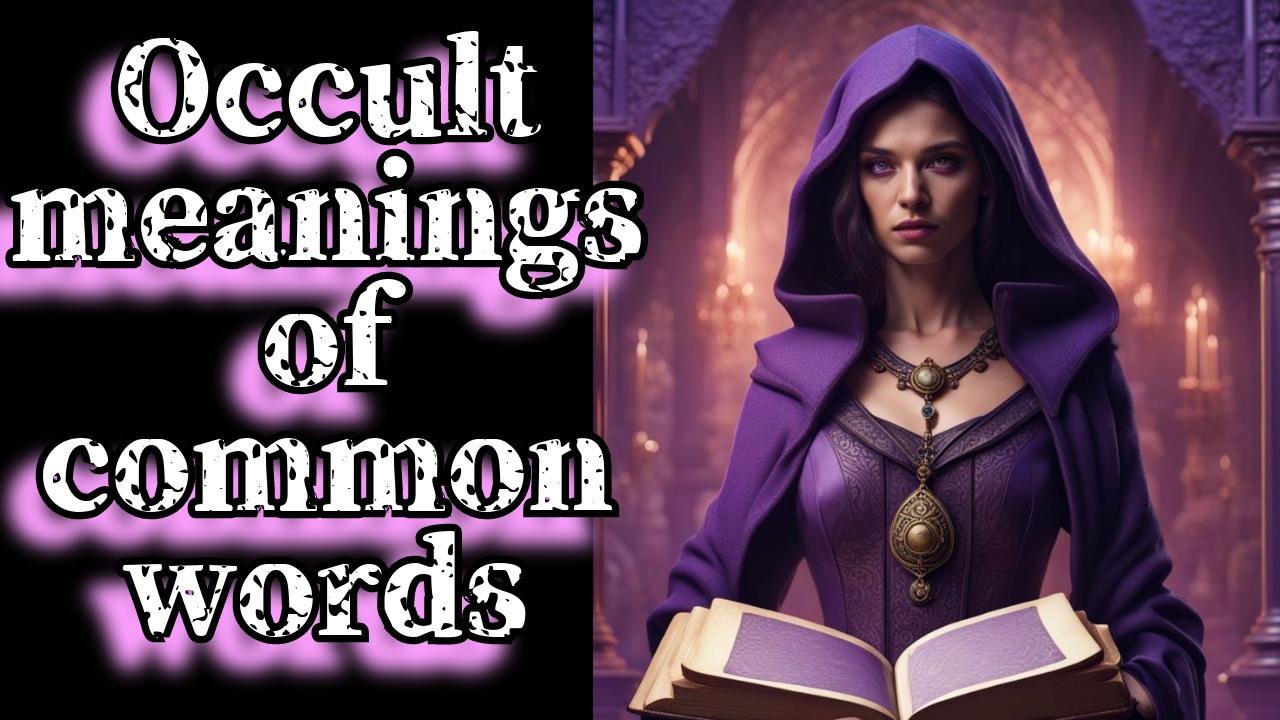
Language is a fascinating tapestry woven with threads of history, culture, and symbolism. Unbeknownst to the majority of people, our words have immense power to build magnificent structures or raze something to the ground, lift people up or tear people down. We can use words to subdue, persuade, excite, depress, manipulate, overcome, comfort, soothe, destroy or even create. Many of us bumble about and spill our words carelessly not paying attention to what we are actually saying and not realising the power our words have, not only for others, but also for ourselves, leaving ourselves with an imprint on the subconscious mind.
Speakers of different languages, or polyglots, have a keen sense of recognizing word patterns or groups, word roots and origins and may have a knack for understanding words on a deeper level.
But beneath the surface of common Esoteric words, there often lies a hidden reservoir of occult meanings, connecting the mundane to the mystical. These esoteric layers add depth and nuance to everyday communication, revealing a hidden dimension that transcends the surface level of language. The hidden dimension that we must be ever so cautious to approach inattentively.
Let’s have a gander at some very common English words with very occult meanings.
Spell
Consider the word “spell,” for instance. Derived from Old English and Proto-Germanic sources, “spell” originally referred to a saying, tale, or narrative. Today it means to say the letters of a word. Can you “spell” the word opinion, for example? However, beyond its conventional usage to denote a series of letters forming a word, it harbors a clandestine link to ancient incantations. In the realm of the occult, a spell is a ritualized expression of intention, a fusion of words and symbolic actions to influence the unseen forces governing reality. Thus, every utterance becomes a potential spell, shaping the fabric of existence through the subtle art of language.
This is why some individuals seem to have a magic touch when dealing with people – they can charm and enchant.
We even have phrases like, do I have to spell it out for you? Do I have to explain it to you.
He put a spell on me- meaning, I am infatuated with him.
Having a dry spell – meaning a period of dry weather
For a spell, as in – come rest for a spell, meaning for a short period of time
Symbol
The word symbol has a rich history deeply entwined with ancient philosophical and religious thought, as well as occult traditions. The word “symbol” extends beyond its dictionary definition as a visual representation. It comes comes from the Greek “symbolon,” referring to a token or sign.
In ancient Greece, a symbolon was a physical object broken in two, with each person holding one part. When brought together, these pieces served as a tangible proof of identity or agreement.
In occult traditions, symbols are conduits of cosmic energy, serving as portals to deeper truths. The pentagram, for example, is not merely a five-pointed star; it embodies the elements and spiritual principles, encapsulating the esoteric balance within the microcosm and macrocosm.
The term evolved to encompass abstract representations that conveyed deeper meanings and became potent tools for expressing complex ideas in art, religion, and mysticism. They bridge the material and spiritual realms, transcending language barriers to communicate universal truths.
Inspire
Delve into the word “inspire,” and a hidden alchemy emerges. Originating from the Latin “inspirare,” meaning “to breathe into”, it suggests a divine infusion of spirit. In the occult lexicon, inspiration is not mere creativity; it is a communion with the transcendent, a channeling of higher energies that illuminate the human psyche. Artists and mystics alike seek this ethereal breath to elevate their works beyond the mundane. So when someone feels “inspired” they literally feel like a Divine energy has entered into their body, giving them a powerful creative boost and motivating them to reach their goals and succeed.
Sincere
The seemingly innocuous term “sincere” unravels a narrative rooted in ancient Rome. The word “sincere” traces its origins to the Latin words “sine” (without) and “cera” (wax). In ancient times, unscrupulous merchants would use wax to fill in cracks in faulty pottery, deceiving buyers. True, sincere objects were those without such hidden flaws. In the occult context, sincerity is akin to spiritual purity, a state of being unblemished by deceit or impurity. To be sincere is to align oneself with the divine essence, cultivating a transparent connection to the cosmic truth.
Enchant
The word enchant comes from the Old French “enchanter” and Latin “incantare,” meaning “to sing upon” or “to utter a magic formula,” in France, even today you say enchanter when meeting someone for the first time…. literally, I am captivated by you / or pleased to meet you.
In fact, to “enchant” in the occult goes beyond charming or captivating. In the occult sphere it involves the infusion of mystical energy into the ordinary. To enchant something is to cast a spell upon it, to imbue it with magical power. It is the subtle weaving of unseen forces, transforming the mundane into the extraordinary.
Charm
Which goes along with charm – to charm someone, can mean literally to put a spell on someone.
“Charm” comes from the Latin “carmen,” meaning an incantation or spell. In ancient times, a charm wasn’t just a trinket; it held magical properties. Uttering specific words or phrases was believed to invoke supernatural forces, providing protection or influencing events. The idea of a charm as an object with mystical significance has persisted across cultures. Amulets and talismans, often inscribed with symbols or words, are believed to possess protective or beneficial qualities, embodying the ancient notion of charms as conduits of hidden forces.
So if you say that nice looking man or good looking woman is charming …. well, they may have just put a spell on you!
Ritual
The word ritual comes from the Latin, derives from the Latin ritualis, “that which pertains to rite / ritus , meaning “custom, usage,” especially “a religious observance or ceremony” and the term transcends its commonplace association with tradition. In the occult realm, rituals are sacred acts that bridge the earthly and the divine. Through carefully choreographed ceremonies, practitioners tap into the reservoir of cosmic energies, aligning themselves with the archetypal forces that shape the universe. Language, as an integral part of ritual, becomes a medium to commune with the numinous.
Omen
Consider the word “omen” meaning any event believed to signal the coming of something good or evil . Omen” stands as a linguistic portal to the mystical. Its roots extend into the Latin word “os,” meaning mouth, and old latin “osmen,” indicating an utterance or speech. In ancient times, omens were often perceived as divine messages communicated through the spoken word, bridging the ethereal and mundane realms. It is is a symbolic message from the unseen realms. In the occult tapestry, signs and symbols are not arbitrary; they are the language of the cosmos, communicating messages that transcend the limitations of the material world. To interpret omens is to decipher the cosmic script written in the events of everyday life.
Intuition
Unravel the layers of the word “intuition,” and a mystical knowing emerges. Rooted in the Latin “intueri,” Latin intueri “look at, consider,” from in- “at, on” (from PIE root *en “in”) + tueri “to look at, watch over” meaning to look inside, intuition transcends rational thought. In ancient philosophy, intuition was considered a direct perception of truth without the need for conscious reasoning. The concept was central to Neoplatonism, where individuals sought to connect with the divine through intuitive insights. Intuition also played a crucial role in Eastern philosophies, where it was associated with the cultivation of inner wisdom and enlightenment. In both traditions, intuition transcends rational thought, tapping into a deeper, more profound understanding of reality.
In the occult landscape, intuition is the whisper of the soul, a direct connection to the wisdom of the cosmos. Language, in its intuitive expression, becomes a conduit for ancient truths that bypass the intellect and resonate with the deeper currents of the unconscious.
Spirit
The word Spirit also has a deeper, occult meaning. The word “spirit” originates from the Latin “spiritus,” meaning “breath” or “soul.” Its etymology suggests a connection between breath and life force. In various cultures, “spirit” transcends its literal meaning, embodying a profound, unseen essence that animates living beings, the intangible aspects of existence. In religious contexts, it often refers to the divine or incorporeal essence within humans. It is related to ghosts, the paranormal.
But Beyond religious and metaphysical realms, “spirit” conveys the essence of enthusiasm, courage, or resilience, such as in the phrase – she came over and lifted his spirits, meaning, she made him feel better, she helped improve his attitude.
We also have a mean spirited individual, meaning they are not nice. – Their soul energy is something negative. On the contrary, a kindred spirit is someone kind at heart, a positive soul energy, while being in high spirits is being full of life force energy, full of vitality.
A free-spirited person is someone who embodies the essence of life itself – a non conformist, a free being guided by the divine life source.
And what about alchohol – how did the word spirits become known to indicate distilled alcohol? The general theory is that it came from “al-ghawl”, whihc means “spirit” in Arabic. It is referenced in the Qur’an in verse 37:47, which uses “al-ghawl” to describe a demon that produces a sense of intoxication.
Other theories link it to the distillation process itself during the early middle ages. distillation – which, in separating the alcohol of a fermented beverage from the wash, isolates its most powerful, “lively” element. The distillate, in other words, is the freed “spirit” of the formerly diluted liquid. Many folks saw it as the vapors rose up from the distillation process it reminded them of spirits floating up.
Alchemy
Even the word alchemy itself has occult meaning. It comes from old French alquemie, alkimie, used in Medieval Latin as alchymia. This name was itself adopted from the Arabic word al-kīmiyā (الكيمياء). The Arabic al-kīmiyā in turn was a borrowing of the Late Greek term khēmeía (χημεία), also spelled khumeia (χυμεία) and khēmía (χημία), with al- being the Arabic definite article ‘the’.
In the labyrinth of language, the word “alchemy” beckons with hidden wisdom. Beyond its historical association with transmuting base metals into gold, alchemy is a metaphor for spiritual transformation. It is the arcane science of refining the soul, turning the leaden aspects of human nature into the golden essence of enlightenment. Language, in the alchemical crucible, becomes a transformative elixir, transfiguring the mundane into the sacred.
These glimpses into the hidden occult meanings of common English words unveil a rich tapestry where language serves as a bridge between the mundane and the mystical. In this esoteric exploration, words cease to be mere tools of communication; they become vessels of arcane wisdom, carrying the resonance of ancient truths that echo through the corridors of time. Language, then, becomes a sacred script, inscribed with the mysteries of existence, inviting those who dare to unravel its secrets into a deeper understanding of the hidden realms.
And since our words do have power, It is very true, be careful what you wish for!
Which words do you know that have occult, or hidden meanings? Are they in English or a different language? We’d love to hear about it in the comments below!
Video version here:
Occult meanings of common Esoteric words
Interesting sources, additional info, images, credits, attributions and other points of views here:
https://etymology.en-academic.com/25854/omen
https://www.etymonline.com/search?q=omen




